The goals for STEM education are largely agreed, nationally and internationally. Work over the last 30 years in the research and development community, epitomized by ISDDE, has shown how to develop tools and processes for teaching, assessment and professional development that enable typical teachers to teach much better mathematics and science much more effectively. Why is this not reflected in most classrooms, and what can be done about it? This paper presents an analysis of the barriers to progress and an explicit model for tackling them.
Issue 12 – March 2019
Welcome to Educational Designer #12
This issue contains four contributions related to the third goal of ISDDE: to increase increasing our impact on educational practice. Hugh Burkhardt has analysed the problem of making impact and the reasons for it. Moreover, he has developed a model to present to policy makers and their advisors to alleviate it. He presents the background to his model in his paper "Improving policy and practice: ISDDE's third goal" and demonstrates how these ideas might be presented to policy makers by including a paper addressed to them: "Towards Research-based Education: integrating policy, research and practice". The journal welcomes considered reactions to this model and suggestions for other approaches.
Zalman Usiskin's 2017 ISDDE Lifetime Achievement Award recognised the substantial impact that his work has had on practice. His paper intertwines themes of the beauty and deep interconnections in mathematics with serendipity in his long career, as he describes the insights, principles, mathematical values and persistence behind the University of Chicago School Mathematics Project.
Berenice Michels and Harrie Eijkelhof describe the creation of 'Nature, Life and Technology' an interdisciplinary STEM upper secondary subject in Netherlands. They discuss the substantive and procedural principles used during the design and development, and reflect on their success.
Tobin White, Corey Brady, Jason Huang & Michael Stevens are designing tools to support student participation in mathematically rich collaborative activities. They describe three variations of their 'Distributed by Design' approach, distributing mathematical objects, or representational views, or mathematical tools which students must coordinate to complete a shared task.
In preparing this issue, I thank the associate editors Dor Abrahamson and Frans van Galen, the anonymous specialist reviewers, assistant editor Sheila Evans and especially Daniel Pead our design editor. The editorial team thanks Dr Max Stephens for his valuable service on our editorial board and we welcome our new member Wout Ottevanger. Wout brings expertise in science education as well as experience in curriculum research, development and implementation at SLO (Netherlands). He spent part of his working life in Africa and so brings an additional perspective to the work of ISDDE.
The editorial team hopes that you find the articles in this issue valuable for your work.
Kaye Stacey
Editor in Chief
Improving Policy and Practice
Hugh Burkhardt
Retrieved from: http://www.educationaldesigner.org/ed/volume3/issue12/article46/
Beauty and Serendipity in Teaching Mathematics
Zalman Usiskin
Serendipity has been defined as the occurrence and development of events by chance in a happy and beneficial way. Beauty is described by one dictionary as "a combination of qualities, such as shape, color, or form, that brings pleasure to the senses or pleasurably exalts the mind or spirit." This paper gives examples of how these two aspects of experience have influenced what I would like to see in mathematics classrooms and my curriculum development work to engender them, prior to and through the work of the University of Chicago School Mathematics Project.
Retrieved from: http://www.educationaldesigner.org/ed/volume3/issue12/article47/
The development and implementation of an interdisciplinary STEM course for upper secondary schools
Berenice I. Michels and Harrie M.C. Eijkelhof
Since 2007, a new interdisciplinary course 'Nature, Life and Technology' (NLT) has been taught in more than 200 Dutch senior high schools by teams of teachers, in addition to the regular courses in mathematics, physics, chemistry, biology and earth science. The goals of NLT are to motivate students for a career in science and technology and to show them the coherence between the traditional STEM subjects. Teams of teachers and experts from research and industry developed more than 80 interdisciplinary modules. This paper describes the development and implementation process, focusing on the design principles in the development of standards, development of materials, professional development (PD), implementation at schools and monitoring activities. From this experience, several lessons can be learned for comparable challenges.
Retrieved from: http://www.educationaldesigner.org/ed/volume3/issue12/article48/
A Distributed-by-Design Approach to Supporting Collaborative Learning with Dynamic Mathematics Software
Tobin White, Corey Brady, WenYen Huang and Michael Stevens
Fostering productive groupwork is a goal for many educators, but it can be difficult to implement effectively in mathematics classrooms. We have developed an approach, and a corresponding set of new tools, intended to support student participation in mathematically rich collaborative learning activities. This paper provides an overview of this 'Distributed by Design' approach. We elaborate key principles by illustrating three variations, in which we alternately distribute distinct but interdependent mathematical objects, views, or tools to each student in a cooperative group, and ask participants to coordinate those elements in completing a shared task. This approach is implemented with our MathNet software.
Retrieved from: http://www.educationaldesigner.org/ed/volume3/issue12/article49/



